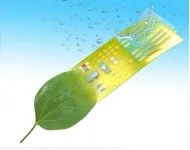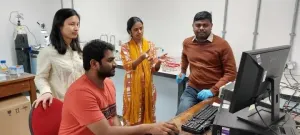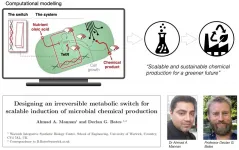UMass Amherst researchers create intelligent electronic microsystems from green material
2021-06-08
(Press-News.org) A research team from the University of Massachusetts Amherst has created an electronic microsystem that can intelligently respond to information inputs without any external energy input, much like a self-autonomous living organism. The microsystem is constructed from a novel type of electronics that can process ultralow electronic signals and incorporates a device that can generate electricity "out of thin air" from the ambient environment.
The groundbreaking research was published June 7 in the journal Nature Communications.
Jun Yao, an assistant professor in the electrical and computer engineering (ECE) and an adjunct professor in biomedical engineering, led the research with his longtime collaborator, Derek R. Lovley, a Distinguished Professor in microbiology.
Both of the key components of the microsystem are made from protein nanowires, a "green" electronic material that is renewably produced from microbes without producing "e-waste." The research heralds the potential of future green electronics made from sustainable biomaterials that are more amenable to interacting with the human body and diverse environments.
This breakthrough project is producing a "self-sustained intelligent microsystem," according to the U.S. Army Combat Capabilities Development Command Army Research Laboratory, which is funding the research.
Tianda Fu, a graduate student in Yao's group, is the lead author. "It's an exciting start to explore the feasibility of incorporating 'living' features in electronics. I'm looking forward to further evolved versions," Fu said.
The project represents a continuing evolution of recent research by the team. Previously, the research team discovered that electricity can be generated from the ambient environment/humidity with a protein-nanowire-based Air Generator (or 'Air-Gen'), a device which continuously produces electricity in almost all environments found on Earth. The Air-Gen invention was reported in Nature in 2020.
Also in 2020, Yao's lab reported in Nature Communications that the protein nanowires can be used to construct electronic devices called memristors that can mimic brain computation and work with ultralow electrical signals that match the biological signal amplitudes.
"Now we piece the two together," Yao said of the creation. "We make microsystems in which the electricity from Air-Gen is used to drive sensors and circuits constructed from protein-nanowire memristors. Now the electronic microsystem can get energy from the environment to support sensing and computation without the need of an external energy source (e.g. battery). It has full energy self-sustainability and intelligence, just like the self-autonomy in a living organism."
The system is also made from environmentally friendly biomaterial - protein nanowires harvested from bacteria. Yao and Lovley developed the Air-Gen from the microbe Geobacter, discovered by Lovley many years ago, which was then utilized to create electricity from humidity in the air and later to build memristors capable of mimicking human intelligence.
"So, from both function and material," says Yao, "we are making an electronic system more bio-alike or living-alike."
"The work demonstrates that one can fabricate a self-sustained intelligent microsystem," said Albena Ivanisevic, the biotronics program manager at the U.S. Army Combat Capabilities Development Command Army Research Laboratory. "The team from UMass has demonstrated the use of artificial neurons in computation. It is particularly exciting that the protein nanowire memristors show stability in aqueous environment and are amenable to further functionalization. Additional functionalization not only promises to increase their stability but also expand their utility for sensor and novel communication modalities of importance to the Army."
INFORMATION:
[Attachments] See images for this press release:

ELSE PRESS RELEASES FROM THIS DATE:
2021-06-08
DURHAM, N.C. - Using drones and artificial intelligence to monitor large colonies of seabirds can be as effective as traditional on-the-ground methods, while reducing costs, labor and the risk of human error, a new study finds.
Scientists at Duke University and the Wildlife Conservation Society (WCS) used a deep-learning algorithm--a form of artificial intelligence--to analyze more than 10,000 drone images of mixed colonies of seabirds in the Falkland Islands off Argentina's coast.
The Falklands, also known as the Malvinas, are home to the world's largest colonies of black-browed albatrosses (Thalassarche melanophris) and second-largest ...
2021-06-08
Researchers from the University of Liège (Belgium) have recently developed a new artificial neuron inspired by the different modes of operation of human neurons. Called a Bistable Recurrent Cell (BRC), this process has enabled recurrent networks to learn temporal relationships of more than a thousand discrete time units where classical methods failed after only a hundred time units. These important results are published in the journal PLOS One.
The enormous interest in artificial intelligence (AI) in recent years has led to the development of extremely powerful machine learning techniques. For example, time series - any series of data where a time component is ...
2021-06-08
The speed of water flow is a limiting factor in many membrane-based industrial processes, including desalination, molecular separation and osmotic power generation.
Researchers at The University of Manchester's National Graphene Institute (NGI) have published a study in Nature Communications showing a dramatic decrease in friction when water is passed through nanoscale capillaries made of graphene, whereas those with hexagonal boron nitride (hBN) - which has a similar surface topography and crystal structure as graphene - display high friction.
The team also demonstrated that water velocity could be selectively controlled by covering the high friction hBN channels with graphene, opening ...
2021-06-08
DURHAM, N.H.--Why did the deer cross the road? According to research from the University of New Hampshire to keep going and going and going. Researchers have discovered the longest distance ever recorded by an adult male white-tailed deer--300 kilometers, or close to 200 miles, in just over three weeks. The finding has important implications for population management and the transmission of disease, especially chronic wasting disease, a fatal neurological disease.
"Deer are one of the most abundant, well-known and intensely managed species of wildlife in the United States," said Remington Moll, assistant ...
2021-06-08
The bad odors produced by the Waste Water Treatment Plants, known as WWTPs, have become a growing concern in the cities and towns that host these facilities and are considered by citizens to be the main cause of the perception of pollution, along with the dust and noise.
Now, and thanks to a collaboration between the Institute for Bioengineering of Catalonia (IBEC) and the company DAM, a new way is being opened to detect and treat these odors.
According to the researchers, "the results obtained in the SNIFFDRONE project (Odor monitoring by drones for environmental purposes) are very positive and represent a significant advance ...
2021-06-08
- Most high-value chemicals are currently produced using fossil fuels - industrial chemistry's use of petroleum accounts for 14% of all greenhouse gas emissions.
- An exciting alternative is to engineer bacteria as "cell-factories" with a genetic switch that reroutes their chemistry to produce high-value chemicals, such as biofuels, polymers and pharmaceuticals.
- The use of expensive chemicals to switch them on severely limits their commercial potential, researchers have used mathematical models to develop a new genetic switch that can use a cheap natural ...
2021-06-08
JUNE 8, 2021, NEW YORK - A study conducted by researchers at the Ludwig Center at Harvard has demonstrated how a drug screening method known as dynamic BH3 profiling can be used to quickly identify potentially effective combinations of existing drugs for personalized cancer therapy.
"We know that cancer cells and healthy cells have different metabolisms," said Ludwig Harvard investigator Anthony Letai who, with former postdoctoral researcher Veerle Daniels, led the study reported in the current issue of Science Signaling. "Using BH3 profiling, we found a specific metabolic dependency in triple ...
2021-06-08
Published monthly, the journal CHEST® features peer-reviewed, cutting-edge original research in chest medicine: Pulmonary, critical care, sleep medicine and related disciplines. Journal topics include asthma, chest infections, COPD, critical care, diffuse lung disease, education and clinical practice, pulmonology and cardiology, sleep and thoracic oncology.
The June issue of CHEST includes 95 articles, clinically relevant research, reviews, case series, commentary and more. Each month, the journal also offers END ...
2021-06-08
A new Alzheimer's disease drug will hit the market soon, the first in nearly two decades. But some experts say the evidence for it isn't terribly strong and worry that it may cost a lot.
Still, the announcement of its approval by the U.S. Food and Drug Administration made headlines nationwide. The attention reflects the toll dementia takes on patients, families and society, and the lack of good treatment options.
Meanwhile, millions of adults could lower the chance that they'll ever need a drug like that. To do so, they will need to work with their primary care providers and use the power ...
2021-06-08
There is a growing body of evidence supporting airborne transmission of SARS-CoV-2, the virus that causes COVID-19. Despite updates from the World Health Organization, the U.S. Centers for Disease Control and Prevention (CDC) and the Public Health Agency of Canada that the virus can be transmitted by short- and long-range aerosols, Canada's public health guidance has not been adequately updated to address this mode of transmission, argue authors of a commentary published in CMAJ (Canadian Medical Association Journal)
Canadian public health guidance and practices should be updated to include more emphasis on the following airborne mitigation measures: ventilation, filtration and better masks.
"Ventilation is a key element in the fight against airborne transmission. We need clear guidelines ...
LAST 30 PRESS RELEASES:
[Press-News.org] UMass Amherst researchers create intelligent electronic microsystems from green material






